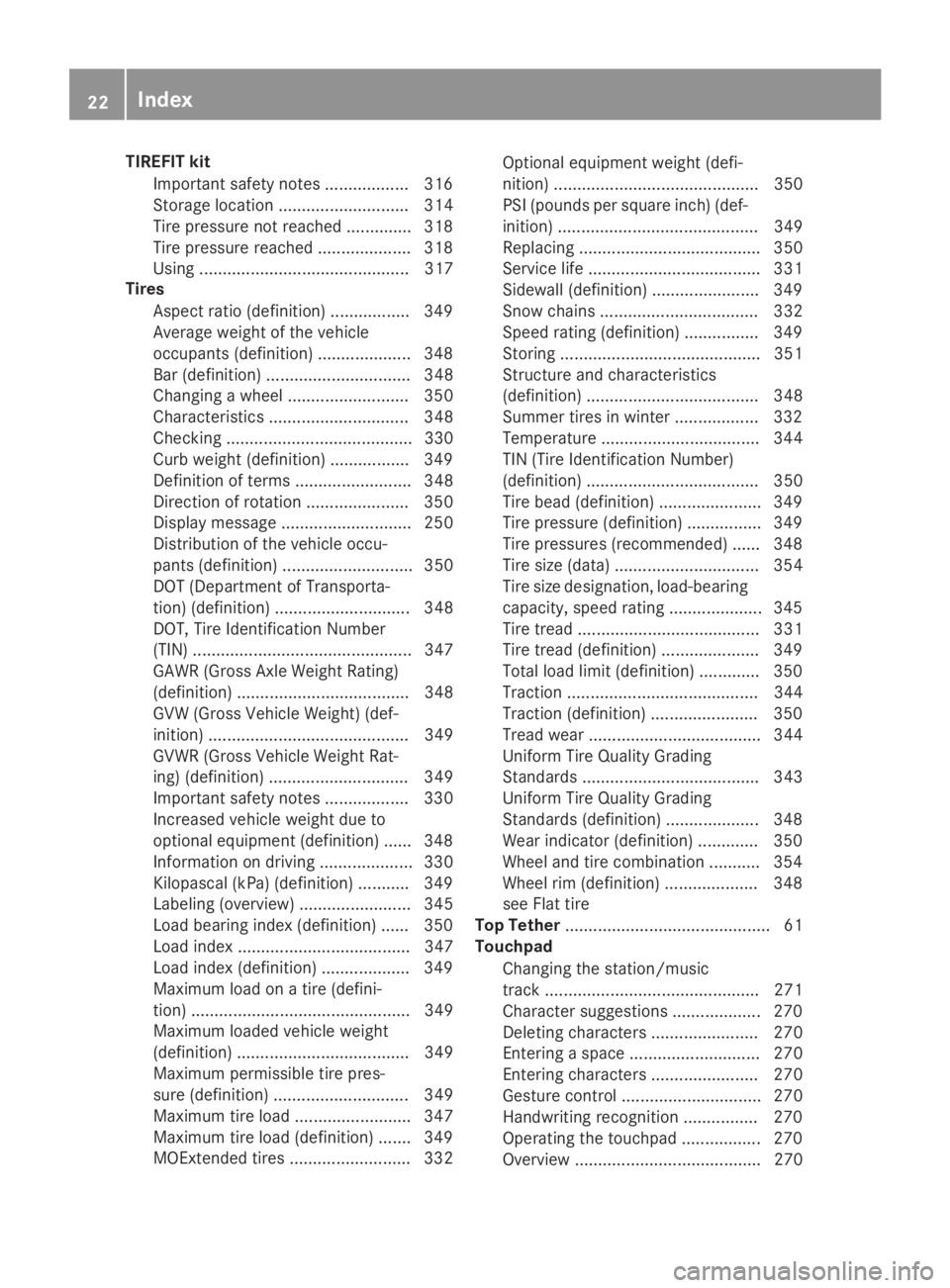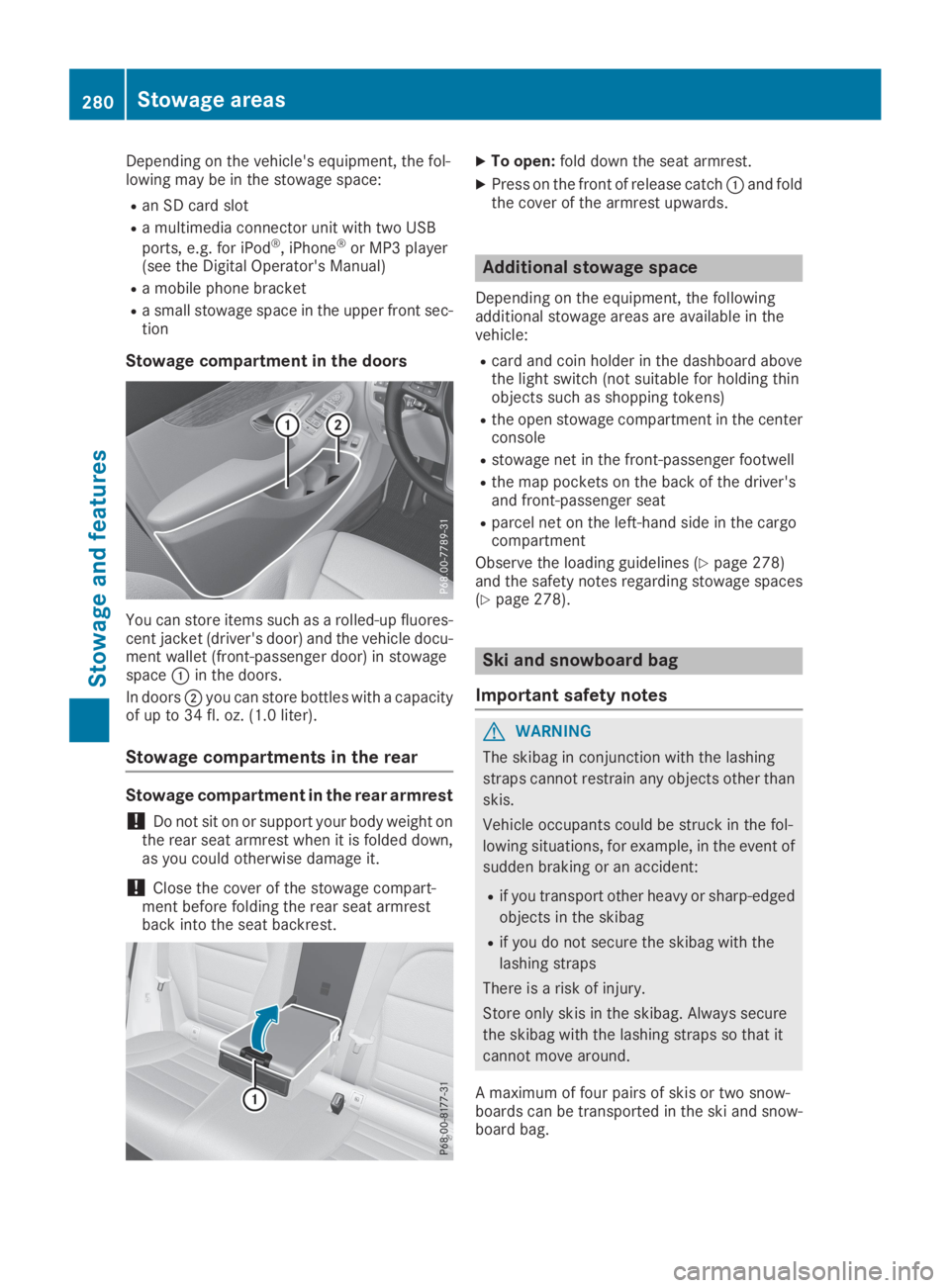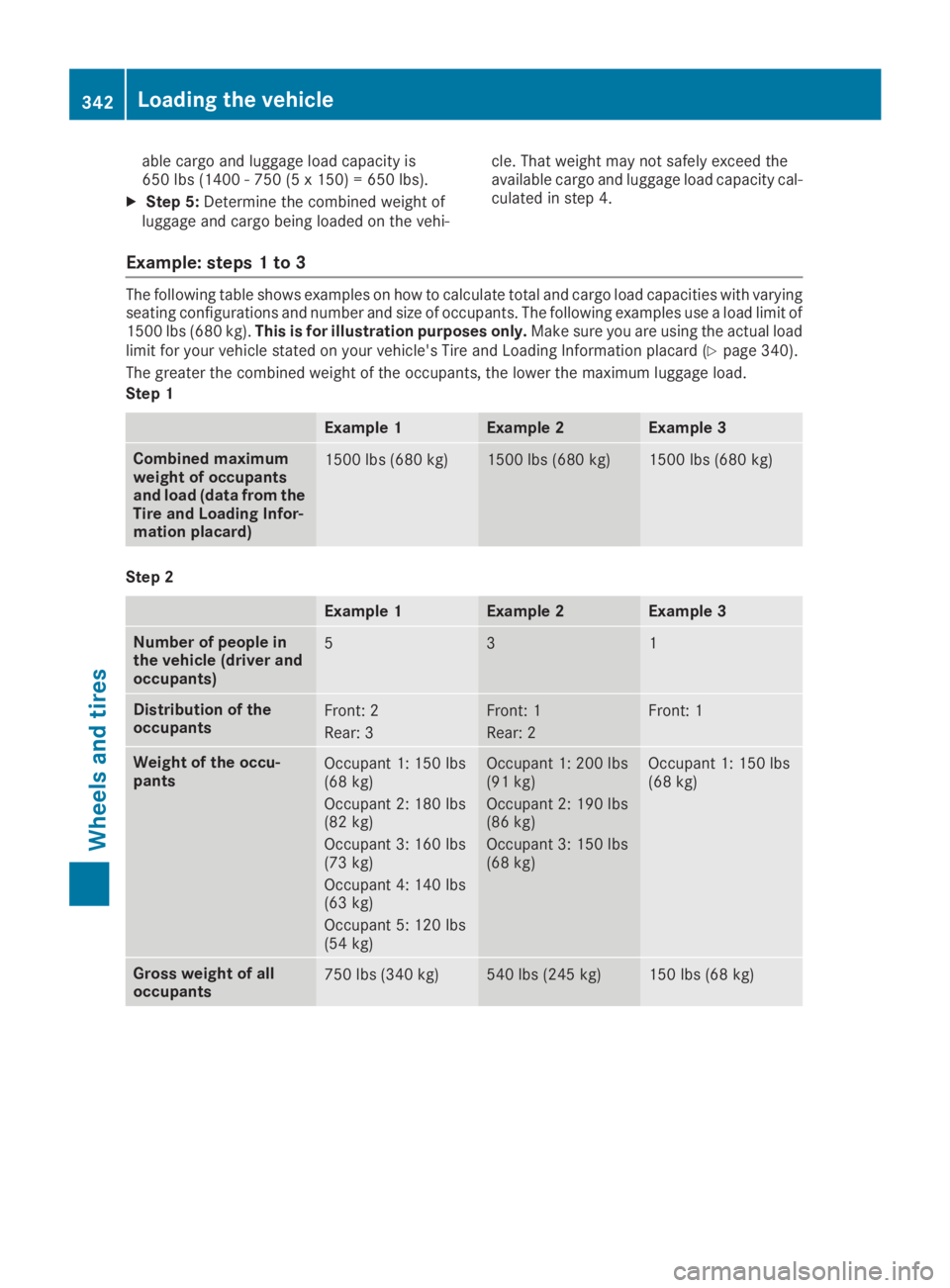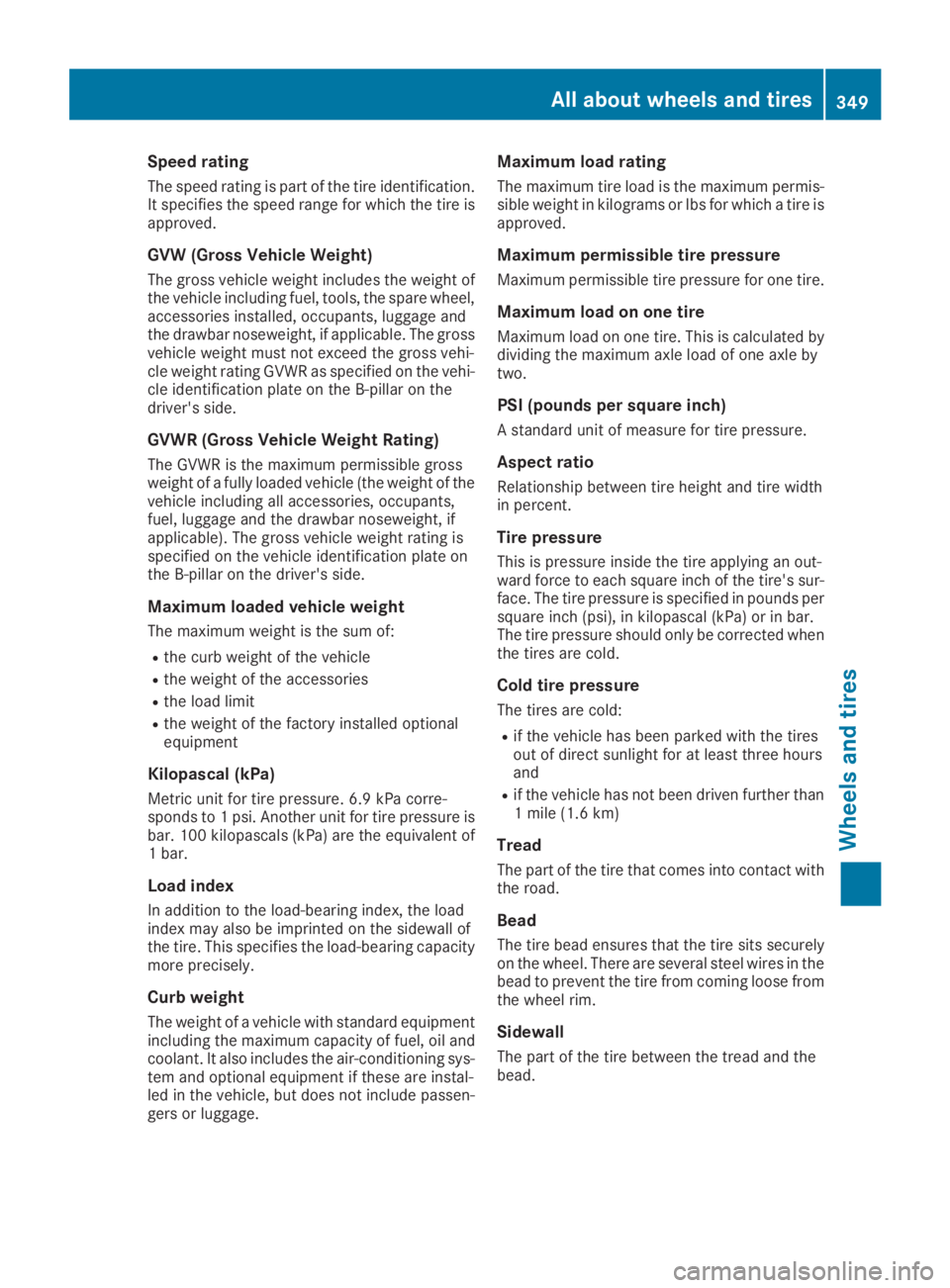2019 MERCEDES-BENZ GLC load capacity
[x] Cancel search: load capacityPage 24 of 370

TIREFIT kit
Important safety notes .................. 316
Storage location ............................ 314
Tire pressure not reached .............. 318
Tire pressure reached.................... 318
Using ............................................. 317
Tires
Aspect ratio (definition) ................. 349
Average weight of the vehicle
occupants (definition) .................... 348
Bar (definition) ............................... 348
Changing a wheel.......................... 350
Characteristics .............................. 348
Checking ........................................ 330
Curb weight (definition) ................. 349
Definition of terms ......................... 348
Direction of rotation ...................... 350
Display message ............................ 250
Distribution of the vehicle occu-
pants (definition) ............................ 350
DOT (Department of Transporta-
tion) (definition) ............................. 348
DOT, Tire Identification Number
(TIN) ............................................... 347
GAWR (Gross Axle Weight Rating)
(definition) ..................................... 348
GVW (Gross Vehicle Weight) (def-
inition) ........................................... 349
GVWR (Gross Vehicle Weight Rat-
ing) (definition) .............................. 349
Important safety notes .................. 330
Increased vehicle weight due to
optional equipment (definition) ...... 348
Information on driving .................... 330
Kilopascal (kPa) (definition) ........... 349
Labeling (overview) ........................ 345
Load bearing index (definition) ...... 350
Load index ..................................... 347
Load index (definition) ................... 349
Maximum load on a tire (defini-
tion) ............................................... 349
Maximum loaded vehicle weight
(definition) ..................................... 349
Maximum permissible tire pres-
sure (definition) ............................. 349
Maximum tire load ......................... 347
Maximum tire load (definition) ....... 349
MOExtended tires.......................... 332
Optional equipment weight (defi-
nition) ............................................ 350
PSI (pounds per square inch) (def-
inition) ........................................... 349
Replacing ....................................... 350
Service life ..................................... 331
Sidewall (definition) ....................... 349
Snow chains .................................. 332
Speed rating (definition) ................ 349
Storing ........................................... 351
Structure and characteristics
(definition) ..................................... 348
Summer tires in winter .................. 332
Temperature .................................. 344
TIN (Tire Identification Number)
(definition) ..................................... 350
Tire bead (definition) ...................... 349
Tire pressure (definition) ................ 349
Tire pressures (recommended) ...... 348
Tire size (data) ............................... 354
Tire size designation, load-bearing
capacity, speed rating .................... 345
Tire tread ....................................... 331
Tire tread (definition) ..................... 349
Total load limit (definition) ............. 350
Traction ......................................... 344
Traction (definition) ....................... 350
Tread wear ..................................... 344
Uniform Tire Quality Grading
Standards ...................................... 343
Uniform Tire Quality Grading
Standards (definition) .................... 348
Wear indicator (definition) ............. 350
Wheel and tire combination ........... 354
Wheel rim (definition) .................... 348
see Flat tire
Top Tether............................................ 61
Touchpad
Changing the station/music
track .............................................. 271
Character suggestions ................... 270
Deleting characters ....................... 270
Entering a space ............................ 270
Entering characters ....................... 270
Gesture control .............................. 270
Handwriting recognition ................ 270
Operating the touchpad ................. 270
Overview ........................................ 270
22Index
Page 282 of 370

Depending on the vehicle's equipment, the fol-lowing may be in the stowage space:
Ran SD card slot
Ra multimedia connector unit with two USB
ports, e.g. for iPod®, iPhone®or MP3 player(see the Digital Operator's Manual)
Ra mobile phone bracket
Ra small stowage space in the upper front sec-tion
Stowage compartment in the doors
You can store items such as a rolled-up fluores-cent jacket (driver's door) and the vehicle docu-ment wallet (front-passenger door) in stowagespace�Cin the doors.
In doors�Dyou can store bottles with a capacityof up to 34 fl. oz. (1.0 liter).
Stowage compartments in the rear
Stowage compartment in the rear armrest
!Do not sit on or support your body weight onthe rear seat armrest when it is folded down,as you could otherwise damage it.
!Close the cover of the stowage compart-ment before folding the rear seat armrestback into the seat backrest.
XTo open:fold down the seat armrest.
XPress on the front of release catch�Cand foldthe cover of the armrest upwards.
Additional stowage space
Depending on the equipment, the followingadditional stowage areas are available in thevehicle:
Rcard and coin holder in the dashboard abovethe light switch (not suitable for holding thinobjects such as shopping tokens)
Rthe open stowage compartment in the centerconsole
Rstowage net in the front-passenger footwell
Rthe map pockets on the back of the driver'sand front-passenger seat
Rparcel net on the left-hand side in the cargocompartment
Observe the loading guidelines (Ypage 278)and the safety notes regarding stowage spaces(Ypage 278).
Ski and snowboard bag
Important safety notes
GWARNING
The skibag in conjunction with the lashing
straps cannot restrain any objects other than
skis.
Vehicle occupants could be struck in the fol-
lowing situations, for example, in the event of
sudden braking or an accident:
Rif you transport other heavy or sharp-edged
objects in the skibag
Rif you do not secure the skibag with the
lashing straps
There is a risk of injury.
Store only skis in the skibag. Always secure
the skibag with the lashing straps so that it
cannot move around.
A maximum of four pairs of skis or two snow-boards can be transported in the ski and snow-board bag.
280Stowage areas
Stowage an d features
Page 344 of 370

able cargo and luggage load capacity is650 lbs (1400 - 750 (5 x 150) = 650 lbs).
XStep 5:Determine the combined weight ofluggage and cargo being loaded on the vehi-
cle. That weight may not safely exceed theavailable cargo and luggage load capacity cal-culated in step 4.
Example: steps 1 to 3
The following table shows examples on how to calculate total and cargo load capacities with varyingseating configurations and number and size of occupants. The following examples use a load limit of1500 lbs (680 kg).This is for illustration purposes only.Make sure you are using the actual loadlimit for your vehicle stated on your vehicle's Tire and Loading Information placard (Ypage 340).
The greater the combined weight of the occupants, the lower the maximum luggage load.
Step 1
Example 1Example 2Example 3
Combined maximumweight of occupantsand load (data from theTire and Loading Infor-mation placard)
1500 lbs (680 kg)1500 lbs (680 kg)1500 lbs (680 kg)
Step 2
Example 1Example 2Example 3
Number of people inthe vehicle (driver andoccupants)
531
Distribution of theoccupantsFront: 2
Rear: 3
Front: 1
Rear: 2
Front: 1
Weight of the occu-pantsOccupant 1: 150 lbs(68 kg)
Occupant 2: 180 lbs(82 kg)
Occupant 3: 160 lbs(73 kg)
Occupant 4: 140 lbs(63 kg)
Occupant 5: 120 lbs(54 kg)
Occupant 1: 200 lbs(91 kg)
Occupant 2: 190 lbs(86 kg)
Occupant 3: 150 lbs(68 kg)
Occupant 1: 150 lbs(68 kg)
Gross weight of alloccupants750 lbs (340 kg)540 lbs (245 kg)150 lbs (68 kg)
342Loading the vehicle
Wheels and tires
Page 351 of 370

Speed rating
The speed rating is part of the tire identification.It specifies the speed range for which the tire isapproved.
GVW (Gross Vehicle Weight)
The gross vehicle weight includes the weight ofthe vehicle including fuel, tools, the spare wheel,accessories installed, occupants, luggage andthe drawbar noseweight, if applicable. The grossvehicle weight must not exceed the gross vehi-cle weight rating GVWR as specified on the vehi-cle identification plate on the B-pillar on thedriver's side.
GVWR (Gross Vehicle Weight Rating)
The GVWR is the maximum permissible grossweight of a fully loaded vehicle (the weight of thevehicle including all accessories, occupants,fuel, luggage and the drawbar noseweight, ifapplicable). The gross vehicle weight rating isspecified on the vehicle identification plate onthe B-pillar on the driver's side.
Maximum loaded vehicle weight
The maximum weight is the sum of:
Rthe curb weight of the vehicle
Rthe weight of the accessories
Rthe load limit
Rthe weight of the factory installed optionalequipment
Kilopascal (kPa)
Metric unit for tire pressure. 6.9 kPa corre-sponds to 1 psi. Another unit for tire pressure isbar. 100 kilopascals (kPa) are the equivalent of1 bar.
Load index
In addition to the load-bearing index, the loadindex may also be imprinted on the sidewall ofthe tire. This specifies the load-bearing capacitymore precisely.
Curb weight
The weight of a vehicle with standard equipmentincluding the maximum capacity of fuel, oil andcoolant. It also includes the air-conditioning sys-tem and optional equipment if these are instal-led in the vehicle, but does not include passen-gers or luggage.
Maximum load rating
The maximum tire load is the maximum permis-sible weight in kilograms or lbs for which a tire isapproved.
Maximum permissible tire pressure
Maximum permissible tire pressure for one tire.
Maximum load on one tire
Maximum load on one tire. This is calculated bydividing the maximum axle load of one axle bytwo.
PSI (pounds per square inch)
A standard unit of measure for tire pressure.
Aspect ratio
Relationship between tire height and tire widthin percent.
Tire pressure
This is pressure inside the tire applying an out-ward force to each square inch of the tire's sur-face. The tire pressure is specified in pounds persquare inch (psi), in kilopascal (kPa) or in bar.The tire pressure should only be corrected whenthe tires are cold.
Cold tire pressure
The tires are cold:
Rif the vehicle has been parked with the tiresout of direct sunlight for at least three hoursand
Rif the vehicle has not been driven further than1 mile (1.6 km)
Tread
The part of the tire that comes into contact withthe road.
Bead
The tire bead ensures that the tire sits securelyon the wheel. There are several steel wires in thebead to prevent the tire from coming loose fromthe wheel rim.
Sidewall
The part of the tire between the tread and thebead.
All about wheels and tires349
Wheels and tires
Z
Page 354 of 370

must be positioned vertically, directly under
the jacking point of the vehicle.
!Only position the jack at the appropriatejacking point of the vehicle. Otherwise, youcould damage the vehicle.
Observe the following when raising the vehi-cle:
RTo raise the vehicle, only use the vehicle-spe-cific jack that has been tested and approvedby Mercedes-Benz. If used incorrectly, thejack could tip over with the vehicle raised.
RThe jack is designed only to raise and hold thevehicle for a short time while a wheel is beingchanged. It must not be used for performingmaintenance work under the vehicle.
RAvoid changing the wheel on uphill and down-hill slopes.
RBefore raising the vehicle, secure it from roll-ing away by applying the parking brake andinserting wheel chocks. Do not disengage theparking brake while the vehicle is raised.
RThe jack must be placed on a firm, flat andnon-slip surface. On a loose surface, a large,flat, load-bearing underlay must be used. On aslippery surface, a non-slip underlay must beused, e.g. rubber mats.
RDo not use wooden blocks or similar objectsas a jack underlay. Otherwise, the jack will notbe able to achieve its load-bearing capacitydue to the restricted height.
RMake sure that the distance between theunderside of the tires and the ground does notexceed 1.2 in (3 cm).
RDo not place your hands or feet under theraised vehicle.
RDo not lie under the vehicle.
RDo not start the engine when the vehicle israised.
RNever open or close a door or the tailgatewhen the vehicle is raised.
RMake sure that no persons are present in thevehicle when the vehicle is raised.
XUsing lug wrench�C, loosen the bolts on thewheel you wish to change by about one fullturn. Do not unscrew the bolts completely.
The jacking points are located just behind thefront wheel housings and just in front of the rearwheel housings (arrows).
XTake the ratchet wrench out of the tire-chang-ing tool kit and place it on the hexagon nut ofthe jack so that the lettersAUFare visible.
XPosition jack�